
About UsThe Numismatic Bibliomania Society is a non-profit organization promoting numismatic literature. For more information please see our web site at coinbooks.org SubscriptionsThose wishing to become new E-Sylum subscribers (or wishing to Unsubscribe) can go to the following web page link MembershipThere is a membership application available on the web site Membership Application To join, print the application and return it with your check to the address printed on the application. Membership is only $15 to addresses in the U.S., $20 for First Class mail, and $25 elsewhere. For those without web access, write to: David M. Sundman, Secretary/TreasurerNumismatic Bibliomania
Society AsylumFor Asylum mailing address changes and other membership questions, contact David at this email address: dsundman@LittletonCoin.com SubmissionsTo submit items for publication in The E-Sylum, just Reply to this message, or write to the Editor at this address: whomren@coinlibrary.com
BUY THE BOOK BEFORE THE COINYou won't regret it! |
- WAYNE'S WORDS: THE E-SYLUM OCTOBER 10, 2010
- SKLOW NUMISMATIC LITERATURE SALES #11 AND #12
- DAVID GRIFFITHS REFERENCE LIBRARY SALE RESULTS
- KOLBE & FANNING 119TH AUCTION SALE CLOSES NOVEMBER 18, 2010
- KARL MOULTON'S FALL/WINTER 2010 FIXED PRICE LIST
- NEW BOOK: FRENCH MEDALLIC ART 1870-1940
- NEW BOOK: WARMAN'S U.S. COIN COLLECTING BY ALAN HERBERT
- ENCYCLOPEDIA OF ROMAN IMPERIAL COINS HIGHLY SOUGHT
- MORE ON RARE COIN INVESTING BY DAVID GANZ
- U.S. MINT DIRECTOR A. PIATT ANDREW
- COLONEL GREEN COIN COLLECTION INVENTORY SURFACES
- MORE ON PRICES AND VALUES IN NUMISMATIC BOOKS
- RAY WILLIAMS ON THE MAINE PENNY
- 1943 "COPPER" CENT IS A MAGICIAN'S PIECE
- CHIPPING AWAY AT B. MAX MEHL'S COST CODE
- NOTES FROM JOE BOLING: OCTOBER 10, 2010
- QUERY: HOW TO REMOVE PAPER MONEY FROM A LAMINATED ENCASEMENT
- QUERY: INFORMATION ON RICHARD D. KENNEY SOUGHT
- QUERY: CALIFORNIA REFINERS OF NEVADA BULLION SOUGHT
- THE COLONIAL COIN & STAMP COMPANY
- HOLABIRD-KAGIN WESTERN AMERICANA AUCTION OCTOBER 29-30, 2010
- MORE ON THE DALTON GANG QUARTER
- MORE ON THE CALIFORNIA HUMIDOR
- ELONGATED COIN-MAKING MACHINES IN JAPAN
- DIGITIZING THE PERSONAL LIBRARY
- CONFESSIONS OF A USED-BOOK SALESMAN
- BRITISH POLICE RAID OFFICE OF BANKNOTE MAKER SECURENCY
- COUNTERFEITER CAUGHT MAKING $5 BILLS INTO $100S
- FUTURE MONEY: NEW CURRENCY FOR SPACE TRAVELERS
- LARRY MITCHELL ON LUST IN THE STACKS
- FEATURED WEB SITE: THE MARIA THERESA THALER
WAYNE'S WORDS: THE E-SYLUM OCTOBER 10, 2010

Among our new subscribers this week is (returning subscriber) Peter Mosiondz, Jr. Welcome aboard! We now have 1,370 subscribers.
Thanks to John Salyer for uploading some images for this week's issue. We open with information on two recently closed numismatic literature sales, and updates regarding Kolbe & Fanning and Karl Moulton. Other topics this week include Mint Director A. Piatt Andrew, author Richard D. Kenney, counterfeiting, and "space money".
To learn about the Pinal Gold and Silver Note, making elongated coins in Japan, and lust in the library stacks, read on. Have a great week, everyone!
Wayne Homren
Numismatic Bibliomania Society
SKLOW NUMISMATIC LITERATURE SALES #11 AND #12
 DAVID SKLOW - FINE NUMISMATIC BOOKS Sale #11, Closed Saturday October 9, 2010, a hearty thank you, to all bidders and consignors! Prices realized will be posted [as soon as possible] on my web site
www.finenumismaticbooks.com
PH: (719) 302-5686, FAX: (719) 302-4933. EMAIL: numismaticbooks@aol.com. USPS: Box 6321, Colorado Springs, CO. 80934.
DAVID SKLOW - FINE NUMISMATIC BOOKS Sale #11, Closed Saturday October 9, 2010, a hearty thank you, to all bidders and consignors! Prices realized will be posted [as soon as possible] on my web site
www.finenumismaticbooks.com
PH: (719) 302-5686, FAX: (719) 302-4933. EMAIL: numismaticbooks@aol.com. USPS: Box 6321, Colorado Springs, CO. 80934.
Highlights for Sale # 12, February 12, 2011. Include the Q. David Bowers Research Library Sale Part IV and other consignments are viewable at my web site, of special interest is a VERY RARE 1881 first edition of Frank Andrews 1816-1857 Large Cents.
DAVID GRIFFITHS REFERENCE LIBRARY SALE RESULTS
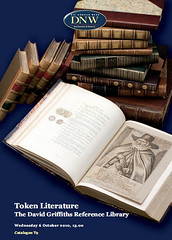 The auction of the David Griffiths reference library of British token literature, staged by Dix Noonan Webb on October 6th, was a success, the 301 lots bringing an equivalent total of US $116,015 including buyers' premium. There were 29 different buyers, mostly from the UK.
The auction of the David Griffiths reference library of British token literature, staged by Dix Noonan Webb on October 6th, was a success, the 301 lots bringing an equivalent total of US $116,015 including buyers' premium. There were 29 different buyers, mostly from the UK.
Principal lots were:
- 4215 Thomas Sharp, A Catalogue of Provincial Copper Coins, Tokens…described from the originals in the collection of Sir George Chetwynd, 1834, ex libris Boyne, Cutting, Davis, Waters, Eklund and Gibbs, $7,450
- 4290 Christopher Williams, A Descriptive List of the Provincial Copper Coins, 1795, ex libris Sarah Banks and Royal Mint Library, $4,000
- 4191 Charles Pye, A Representation of Provincial Copper Tokens, 1916, printer's proof, ex libris Waters, Hudson and Craige, $3,800
- 4205 Richard Samuel, Articles and Notes from The Bazaar, Exchange and Mart, 1880-9, ex libris Jacobs and Jan, $3,450
- 4192 Charles Pye, A Representation of Provincial Copper Tokens, 1916, ex libris Jan, $3,050
- 4214 Thomas Sharp, A Catalogue of Provincial Copper Coins, Tokens…described from the originals in the collection of Sir George Chetwynd, 1834, uncorrected proof copy, ex libris Koorlander, $3,050.
For more information, see: www.dnw.co.uk
To read the earlier E-Sylum article, see: DIX NOONAN WEB TO OFFER GRIFFITHS BRITISH TRADE TOKEN BOOKS OCTOBER 6, 2010 (www.coinbooks.org/esylum_v13n39a05.html)
KOLBE & FANNING 119TH AUCTION SALE CLOSES NOVEMBER 18, 2010
 Kolbe & Fanning Numismatic Booksellers announce their 119th auction sale, closing on November 18, 2010. The 60-page, 588-lot catalogue comprises a diverse selection of interesting and elusive works on ancient, medieval and modern numismatics, and is particularly rich in rare and unusual works on American numismatics.
Kolbe & Fanning Numismatic Booksellers announce their 119th auction sale, closing on November 18, 2010. The 60-page, 588-lot catalogue comprises a diverse selection of interesting and elusive works on ancient, medieval and modern numismatics, and is particularly rich in rare and unusual works on American numismatics.
Featured in the sale among the many interesting lots of American interest are:
- the Currency Act of 1764, a rare British Parliamentary Act regulating American colonial paper money, the severe restriction of which provided in part the justification of the American Revolution;
- the Wayne Homren collection of some fifty early American newspapers with numismatic content, including a 1787 description of Fugio coppers, Birmingham coppers in 1752, a 1788 account of the Massachusetts Mint, George Washington's 1792 comments on the establishment of the U.S. Mint, a contemporary account of 1794 dollars, early Mint Reports, a contemporary account of the 1851 Lewis Roper sale, and the 1857 loss of the S.S. Central America;
- nice examples of the first two coin publications of Q. David Bowers, issued in 1955 and 1956, and specially bound combined presentation editions of both the Garrett and Norweb collection sales;
- a special hardbound edition of Barney Bluestone's famous Grinnell paper money sales;
- a 1914 letter from S.H. Chapman to William H. Woodin, discussing plated Gable sale catalogues;
- Evelyn's 1697 Numismata, which includes the earliest illustration of the St. Patrick's coinage;
- Sanborn Partridge's rare 1979 article on Vermont coins, hand-annotated by the author;
- the famous 1878 Adolph Weyl sale of the Fonrobert collection of over 6,000 American and Canadian coins, tokens and medals; a nice first edition, first printing of the Red Book;
- a rare antebellum children's guide book with currency tables, published in 1857 in Charleston by William Babcock;
- Confederate States of America publications on currency;
- a nautical almanac for the year 1803 signed by early American naval hero Thomas Truxtun that may well have accompanied Truxtun when he captured the French frigate L'Insurgente in 1799 and during the successful encounter in 1800 with La Vengeance, which resulted in President Jefferson presenting Truxtun with the first Congressional medal made in the United States;
- an interesting collection of American numismatic literature from the Civil War years; and
- two of the rarest limited editions of the Red Book: the 2008 ANS sesquicentennial and 2008 NLG Bash volumes, limited to editions of 250 and 135 copies respectively.
A few of the important works on ancient, medieval and modern numismatics include:
- a fine copy of John Evelyn's 1697 Numismata, the first substantial work on English medals, once in the libraries of Rogers Ruding, Matthew Young and Edward Hawkins;
- a set of the Forni reprint of Babelon's Traité des Monnaies Grecques et Romaines;
- a handsomely bound sales room copy of the iconic 1974 Zurich Kunstfreundes sale of superb ancient Greek coins, with buyers' names and prices;
- a nice selection of Sylloge Nummorum Graecorum fascicules;
- the first 15 volumes, 1960-1989, of Numizmatika i Epigrafika;
- Medina's classic 1924 Medallas Europeas Relativas à América;
- Cayón's 1990-95 four-volume Compendio de las Monedas del Imperio Romano;
- the seldom-encountered Forni reprint of Imhoof-Blumer's Die Antiken Münzen Nord-Griechenlands; and
- Éditions Spéciales of seven Victor Gadoury works on French coins.
A printed catalogue may be obtained by sending $10 to: KOLBE & FANNING NUMISMATIC BOOKSELLERS LLC, 141 W JOHNSTOWN ROAD, GAHANNA OH 43230-2700. The catalogue is also accessible free of charge on the Kolbe & Fanning website at www.numislit.com.
On January 8, 2011, Kolbe & Fanning will be holding a public auction at the Waldorf-Astoria hotel in conjunction with the New York International Numismatic Convention. Consignments of important numismatic works have been streaming in, including the superb Alan Luedeking library of works on Latin American numismatics; classic nineteenth- and early twentieth-century works on Russian numismatics; key works on ancient coins; great classic works on American numismatics; a superb set of the 1791 Beskrivelse over Danske Mynter og Medailler; and an original 1925 Browning work on quarter dollars annotated by Walter Breen.
Consignments of exceptional numismatic works will be accepted for this sale until the end of October. Inquiries may be directed to David F. Fanning at df@numislit.com, (614) 414-0855, or to George F. Kolbe at gfk@numislit.com, (909) 338-6527.
KARL MOULTON'S FALL/WINTER 2010 FIXED PRICE LIST
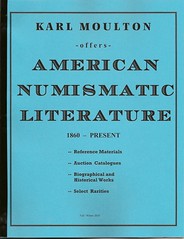
For more information, see: www.coincats.com
NEW BOOK: FRENCH MEDALLIC ART 1870-1940
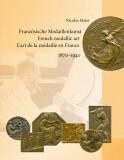 I would like to inform you about the recent publication of a new book on medals.
I would like to inform you about the recent publication of a new book on medals.
The volume "French medallic art 1870-1940" examines the background to the revival of medallic art in France during the nineteenth century and investigates its development down to the 1930s. The wide range of subjects addressed by the artists is evident from the numerous illustrations. In addition, the book provides substantial insights into the medal society founded by Roger Marx, the Société des Amis de la Médaille française (1899-1920). Short biographies are given for a total of 73 artists who decisively influenced French medallic art during the periods of Art Nouveau, Symbolism, Naturalism and Art Deco.
The book is being published in English, German and French. For more information please visit www.french-medallic-art.com
NEW BOOK: WARMAN'S U.S. COIN COLLECTING BY ALAN HERBERT
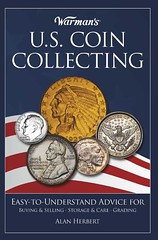 Getting started in coin collecting is as easy as 1, 2, 3 when you get your advice straight from the Answer Man of coin collecting, Alan Herbert.
Getting started in coin collecting is as easy as 1, 2, 3 when you get your advice straight from the Answer Man of coin collecting, Alan Herbert.
In Herbert's exciting new book from Krause Publications, Warman's U.S. Coin Collecting, collectors get everything they need to know about collecting U.S. coins. Whether a coin collector is in it for the pure enjoyment of building a collection they can be proud of, looking for help in identifying the coins they have inherited from a grandparent, fascinated by the historical side of coins, or seeking ways to maybe make a profit from a favorite hobby, this book has it covered.
Topics covered in this easy-to-follow coin primer include:
- What is my coin worth?
- Why to avoid cleaning coins
- Proof coins, proof and mint sets
- Commemorative coins
- Grading coins
- Coins as investment
- Bullion coins
Plus, readers will discover more than 100 questions and answers about U.S. coins, including many little-known facts. For a review copy, contact Grace Proctor at grace.proctor@fwmedia.com. For more information visit www.shopnumismaster.com/product/warmans-us-coin-collecting/us-coins .
Author Alan Herbert is known as "The Answer Man" in his popular columns for Numismatic News, World Coin News, Bank Note Reporter and Coins Magazine. He has authored Coin Clinic and Coin Clinic II for Krause Publications. He has served on the American Numismatic Association Board of Governors and numerous ANA committees. He has been honored by Krause Publications as a Numismatic Ambassador.
ENCYCLOPEDIA OF ROMAN IMPERIAL COINS HIGHLY SOUGHT
Congratulations to author Rasiel "Ras" Suarez. His book, The Encyclopedia of Roman Imperial Coins turns out to be one of the most sought-after out-of-print books in America, according to a report published by Bookfinder.com. -Editor
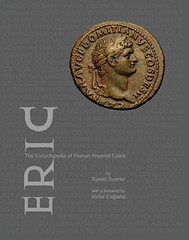 Some books go out of print and simply disappear. But others stay in demand long after their publishers have ceased to print them. Some are collectible, others are unusual, and many are just plain useful. Bookfinder.com annually prints a list of the 100 most sought-after out-of-print books in America over the past year.
Some books go out of print and simply disappear. But others stay in demand long after their publishers have ceased to print them. Some are collectible, others are unusual, and many are just plain useful. Bookfinder.com annually prints a list of the 100 most sought-after out-of-print books in America over the past year.
Last year, the group noted "a rush on personal finance and banking policy books." In 2010, however, frugality seemed to reign as "manuals and do-it-yourself guides for sewing, home repair, and other productive pastimes" took the lead.
Below are the Top 10 books on this year's list. Don't be surprised if you haven't heard of most of them. If you're not a coin collector, for instance, you're unlikely to know No. 10 ("ERIC: The Encyclopedia of Roman Imperial Coins," by Rasiel Suarez). And unless you're a real die-hard Stephen King fan you might not have stumbled upon No. 9 ("Rage," by Stephen King writing as Richard Bachman).
But for one reason or another, these titles all have their fans – even though, in some cases, their authors wish it were not so.
As for a second lease on life, some of these books are popular enough that new editions are a possibility. (No. 13, "Aran Knitting" by Alice Starmore, will be reprinted this year.) But in at least two cases noted below, Bookfinder.com predicts that reprinting will never occur.
To read the complete article, see: Top 100 most sought-after out-of-print books in 2010 (www.csmonitor.com/Books/chapter-and-verse/2010/1006/Top-100-most-sought-after-out-of-print-books-in-2010)
To read the earlier E-Sylum article, see: NEW BOOK: THE ENCYCLOPEDIA OF ROMAN IMPERIAL COINS, SECOND EDITION (www.coinbooks.org/esylum_v13n33a03.html)
MORE ON RARE COIN INVESTING BY DAVID GANZ
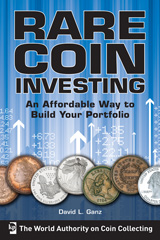 My new book for Krause "Rare Coin Investing: An affordable Way" has an interesting twist. In 1998, I wrote "Planning Your Rare Coin Retirement" (Bonus Books), which I always thought of as a catchy title. While this new book talks about current coin investing, it takes a look at my picks of 1998 which include everything from MS-60 (and MS63) Carson City silver dollars to the 1991 1/4 ounce $10 Eagle gold coin. There was even a foreign gold coin portfolio.
My new book for Krause "Rare Coin Investing: An affordable Way" has an interesting twist. In 1998, I wrote "Planning Your Rare Coin Retirement" (Bonus Books), which I always thought of as a catchy title. While this new book talks about current coin investing, it takes a look at my picks of 1998 which include everything from MS-60 (and MS63) Carson City silver dollars to the 1991 1/4 ounce $10 Eagle gold coin. There was even a foreign gold coin portfolio.
The original premise was selecting a $10,000 portfolio and letting it grow. There are a couple of chapters in the new book that trace the outcome of Planning your rare coin retirement.
The coins and prices that I used in 1998 were all taken from then-current ads in Numismatic News, Coin World, COINage and Coins Magazine. Here's a hint of how my picks were: (in some cases there were choices, so the original portfolio (all coins) [if you bought every recommendation of these mostly contemporary issues] was $12,640. (The fair market value in 2010: over $60,000).
The world gold and platinum portfolio had around 100 coins (actually 104) with an average cost per coin in 1998 of $86.56 ($9,001) for the portfolio. A typical coin was a British sovereign at $84 apiece (Elizabeth II) or "old style" at $87 -- all in XF-AU. Since the sovereign has .2354 troy ounces of gold, With $1,300 gold, sovereigns are now selling for about $333 (or equivalent to $1,414 an ounce); the Swiss 20 Franc (Vreneli) in my book at $70 is on the APMEX site at $275 (about $1,472 an ounce equivalent)..
It's a fair bet that the return on this portfolio of 104 modern gold coins exceeds four times investment (gold never exceeded $300 an ounce in 1998 ands today ($1,313) 4.66 times the 1998 average or about $41,000 on the recommendations.
Not every coin pick was a winner... but overall, it was a pretty good deal. We'll see if the picks this time work as well a dozen years from now. The coins involved in this are very affordable for the typical collector. There are no major rarities (they did well, too).
Debbie Bradley did an outstanding job editing the book.
Of course, in addition to this book for 2010, a bunch of non-numismatic books came out of my typewriter (computer). It included a second edition of "A Critical Guide to Anthologies of African Literature", which the African Studies Association first published in 1973; I brought out a second edition available on Amazon inexpensively when I saw an original edition on eBay for $198. Another book: "Proof of Entitlement to Relief before Planning & Zoning Boards", a 275pp book, part of American Jurisprudence Proof of Facts 3rd series (West, 2010) meaning my writings now span from "A" to "Z".
To read the earlier E-Sylum article, see: NEW BOOK: RARE COIN INVESTING BY DAVID GANZ (www.coinbooks.org/esylum_v13n40a04.html)
U.S. MINT DIRECTOR A. PIATT ANDREW
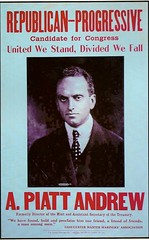 203 A[B RAM] PAITT ANDREW: Political Poster, 14x20"
(1921) heavy board, sepia toned portrait of the candidate
with all text in red. As New. (50.00)
203 A[B RAM] PAITT ANDREW: Political Poster, 14x20"
(1921) heavy board, sepia toned portrait of the candidate
with all text in red. As New. (50.00)
Running for his first term in Congress, Andrew billed himself as REPUBLICAN - PROGRESSIVE. CANDIDATE FOR CONGRESS. UNITED WE STAND, DIVIDED WE FALL/ A. PIATT ANDREW, FORMERLY DIRECTOR OF THE MINT AND ASSISTANT SECRETARY OF THE TREASURY followed by an endorsement from the Gloucester Master Mariner's Association “We have found, hold and proclaim him our friend, a friend of friends, a man among men.” Obviously respected, Andrew served 8 terms and died in office. In the following 75 years, Massachusetts has probably not had 8 terms of a conservative congressman adding all districts together.
For more information on the sale, see: OCTOBER 30, 2010 DAVIS SALE CATALOG AND LOT IMAGES AVAILABLE (www.coinbooks.org/esylum_v13n39a07.html)
THE BOOK BAZARRE
NOVEMBER 18, 2010 AUCTION SALE HIGHLIGHTSAmerican Numismatic Literature From the Civil War Years
Including: Cogan's 1858 Large Cent Sale in Exceptional Condition;
a Rare 1861 Catalogue Featuring the Collection of Daniel Groux;
A Rare 1863 Article on the Controversy Surrounding Benson John
Lossing's Article on Continental Money; an Ante-Fire Chicago Coin Sale;
and Charles Chaplin's Legendary Gointoem Strong Sale
KOLBE & FANNING NUMISMATIC BOOKSELLERS
141 W JOHNSTOWN ROAD, GAHANNA OH 43230-2700
(614) 414-0855 • df@numislit.com • GFK@numislit.com
COLONEL GREEN COIN COLLECTION INVENTORY SURFACES
In an email with the subject line "Numismatic literature gold mine...", Renee Shomaker writes this about a discussion on the CoinCommunity.com web site:
I'm floored at what he has already found in the boxes the heirs wanted to toss! Unbelievable.
Last week I did an estate appraisal in Massachusetts. In the accumulation of papers belonging to the deceased owner is a 442 page "Appraisal Numismatic Collection The Estate of Edward H.R. Green" done for the First National Bank, Boston, Massachusetts. It is dated 1937.
The appraisal is typed on ledger paper and measures 17 1/2 inches by 14 inches bound in brown press board covers.
The appraisal was done by Frederick C.C. Boyd of New York and it includes 51,018 coins, medals and tokens and 61,664 pieces of Paper Money that were in the vault of the bank.
The document is a carbon copy of an original that has been signed by Frederick Boyd and notarized.
My question - Does anyone know what something like this is worth and who would be best to dispose of it. The document is in my possession for disposal.
I also have THOUSANDS of old coin auction catalogs and books that were in the same estate. I have to dispose of all of them. They fill over 100 boxes and weigh a couple tons.
I was initially very surprised to hear that they wanted to throw out everything except the books. The pressure actually came from the Real Estate agent who wanted the house cleaned out. But at least we were able to intervene and save the catalogs before they got too badly damaged.
As far as I know, nothing was actually disposed of off site. They had moved 10 large boxes and a 50 gallon barrel to the garage but they were NOT rained on. Some bending and most labels attached to the cardboard holders were lost, but we picked up everything, so I hope to reassemble the collection as it was on the shelves.
The wealth of interesting material is amazing. I have identified several different types of materials thus far.
Catalogs - If I can believe the labels - a complete set of the auction catalogs from Stacks back to the 1930s. Many catalogs from other auctions dating back to the 1800s.
Books - Mostly Colonial reference books specializing in Connecticut and NJ.
Personal notebooks documenting the portion of the original collection sold by Stacks in 1993 and 2000. Mostly Connecticut coppers some very rare varieties. There is a results sheet for the 2000 sale indicating a payment by Stacks over $600,000 for the Connecticut coppers at that time. The heirs indicate the 1993 sale was larger and exceeded $1,000,000.
For about 20 of the higher grade coins - the original owner George Perkins made aluminum foil impressions of his coins and put them in 2x2 holders with the Maris attributions on them. The time and effort put into the Connecticut coppers by Mr. Perkins is amazing. There are hundreds of pages of notes and correspondence written about Connecticut coppers.
The collector was George C. Perkins who was a collector of colonial coins - primarily Connecticut coppers. When his collection was sold by Stacks in 1993 it was one of the most complete collections of early Conn. varieties known at that time.
Mr. Perkins was also an Attorney and he occupied offices that at one time were used by one of the firms that handled business for Col. Green. As far as I can determine, he was not a direct legal successor to that firm which is critical in this case. The Green material all came from the earlier law firm files. A great deal of the other correspondence may have as well - I simply do not know - no one does.
To read the complete discussion, see: Colonel Green (Edward H.R. Green) Coin Collection Inventory (www.coincommunity.com/forum/topic.asp?TOPIC_ID=72843)
MORE ON PRICES AND VALUES IN NUMISMATIC BOOKS
Howard A. Daniel III writes:
I cannot remember who taught me the difference between a "price" and a "value", but it might have been Fred Schwan of BNR Press when he published my second catalog in 1978. Now, I use Est.(Estimated) Value because I got tired of trying to explain it to the Vietnamese reading my catalogs here in Viet Nam. After I added "Estimated," the questions stopped and they got it.
David Lange writes:
On the subject of including values in catalogs, I had to wrestle with the same question for my coin board book. I ultimately concluded that buyers of the book would feel cheated without pricing information, so I created a table based on a combination of actual sales and mere projections.
Since the book's publication I've tracked every board transaction known to me, and it has become apparent that most coin boards simply don't exist in grades above Very Fine, though I've been valuing them in Near Mint as well. For my 2011 value guide I will most likely omit values for grades that haven't actually surfaced, replacing them with just lines. It seems that this has been the practice for popular coin guides in recent decades, and it's certainly more accurate than purely speculative figures.
Ron Abler wrote to Fred Schwan:
I am writing a book on the Centennial medals of 1876, and I have been resisting the apparent requirement to include what people refer to as a price list. The consensus appears to be that the only thing worse than a price list in the book is no price list in the book. You put it very succinctly, and I plan to quote you (credit given, of course) when I include values (vice prices) and tell my readers your story about the two dealers. Thank you for your permission to do so.
Ron adds:
The die is cast. I will include a value guide in my book, but I will pepper it with caveats, including the quotes from Fred. I have asked for a lot of advice on my book, and I have been given a lot. I have followed a lot, but none with the misgivings that accompany a price list. Fred, though, has given me my spoonful of sugar.
To read the earlier E-Sylum article, see: TO PRICE OR NOT TO PRICE? HERE ARE SOME ANSWERS (www.coinbooks.org/esylum_v13n40a11.html)
RAY WILLIAMS ON THE MAINE PENNY
Regarding the story of the Viking coin unearthed in Ray Williams writes:
 With respect to the Maine Penny being a possible plant by the discoverer, I doubt it. The coin was said to be an English coin at the time and it wasn't until 22 years later that it was discovered to be of Scandinavian origin. If I were to plant a coin to promote Viking habitation in Maine, I would not wait 22 years to correctly attribute the coin to be Viking rather than British...
With respect to the Maine Penny being a possible plant by the discoverer, I doubt it. The coin was said to be an English coin at the time and it wasn't until 22 years later that it was discovered to be of Scandinavian origin. If I were to plant a coin to promote Viking habitation in Maine, I would not wait 22 years to correctly attribute the coin to be Viking rather than British...
1943 "COPPER" CENT IS A MAGICIAN'S PIECE
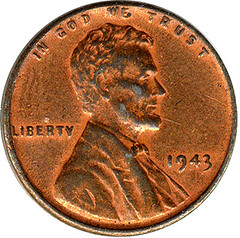
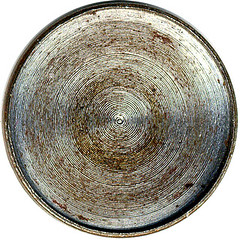
Ron Benice writes:
The hollowed-out 1943 "copper" cent with steel lining is a magician's piece. A dime fits into the hollowed out reverse. The magician, with a palmed magnet, passes his hand over the "penny" and turns it into a dime. I have no explanation of how the cataloger saw the wheat ears on the reverse.
Tom DeLorey writes:
The 1943 cent obverse shell is indeed part of a magician's token. I would surmise that the matching piece had a small, thin magnet glued to it or embedded in it, which would attach itself to the steel shell until the magician performed his sleight of hand. The copper plating was just showmanship, lest the natural grey color of the steel cent make the viewer of the trick suspicious.
Dick Doty of the National Numismatic Collection at the Smithsonian writes:
It definitely was a magician's token. The idea was to change a cent into a dime. The dime nestled underneath the hollowed-out cent. You made a pass over it with your hand (with an alnico magnet hidden between two of your fingers), and shazam! a cent became a dime.
I had one myself, age twelve or so, but it had a thin wafer of steel inside, because it had started out as an ordinary bronze cent. A copper-plated ‘steelie' would've worked better. I eventually planed down a second cent so that it would fit inside the first, and I then launched my two-headed penny into commerce. For all I know, it's still out there, somewhere…
The copperplated 1943 cent illustrated in last week's E-Sylum was indeed a magician's piece. The date is a clue to the trick.
I have had one of these in my collection since the late 1940s, purchased at a magic shop in Washington DC (when I was stationed there in the military service).
It consisted of a small round wooden red box. You open the box, place a penny inside, replace the lid, then have someone in the audience tap the lid. If you are right handed you hold the box in your left hand and lift the lid with your right hand. In place of the cent coin their now exists a dime. You hand the dime around to everyone's amazement and assurance it is a genuine dime.
According to the instructions with the box you are supposed to pull some change out of your pocket and select the cent. I could never master that part.
The cent was a prop. The reverse was machined out so it would fit over a dime. I couldn't keep the dime inside the cent shell inside my pocket with the other coins. So I had to pull out the prepared cent alone.
Question: Have you figured out yet why it should be a 1943 cent?
Answer: There is a tiny magnet it the lid of the box.
Immediately when you replace the lid the cent shell is attracted to the lid. It is already stuck there before you have someone tap the lid. That part is just show business!
Question: Why should you lift the lid with your right hand?
Answer: You palm the cent shell by dragging your fingers across shell to hide it in your palm. That part's easy since everyone is looking at the dime, not what you are doing with your hand.
In my box there is a tiny circle of green felt on both the bottom and lid. That hides the magnet in the lid. You can even pass the box around to your audience afterwards for them to examine.
Now my box and prepared cent was made before 1943 (it had an earlier dated cent). It has an iron disc pasted inside the shell. That provided enough attraction to the hidden magnet to stick the shell to the lid.
The U.S. Treasury made this trick easier by making zinc-coated steel cents in 1943. Trouble is you have to copperplate the 1943 cent first.
To read the earlier E-Sylum article, see: QUERY: AN ODD 1943 COPPER CENT (www.coinbooks.org/esylum_v13n40a13.html)
CHIPPING AWAY AT B. MAX MEHL'S COST CODE
Harry Cabluck of Austin, Texas submitted this attempt to crack the puzzle of B. Max Mehl's cost code described by Ron Guth.
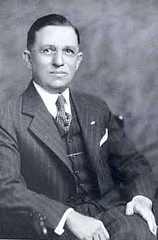 I went to Slavic/Lithuanian/Russian/Hebrew/Greek dictionaries.
In certain languages words for Tuesday and Thursday almost make it.
I went to Slavic/Lithuanian/Russian/Hebrew/Greek dictionaries.
In certain languages words for Tuesday and Thursday almost make it.
As good a guess as anything else: DEZPOTICUS. It cannot be YOUDESPOT, too many O's. Nor YOUDEPOSIT, no room for the C.
The chase is as stimulating as "A GOOD GLASS IN THE BISHOP'S HOSTEL."
Joe Boling suggested asking Simcha Kuritzky. He writes:
What they are describing is a simple cipher. Actually the Greeks invented using letters for numerals--the Hebrew name is Gematria, which is taken directly from the Greek. However, the letters suggested are not the ones used in Greek or Hebrew. Also, both languages did not use letters for digits, they used them for numbers: B = 2 but K = 20 and R = 200. That doesn't fit the cypher described, which was obviously developed by someone familiar with Hindu-Arabic numerals.
There's no reason the letters used have to spell anything, however, I would note that YOUDES could be a pun on Judas, a German or Latinized version of Judah = Jew. But I suspect they don't spell anything in particular.
Dick Johnson writes:
The ecent discussion on B. Max Mehl's cost code brings a lot to mind. Most every dealer uses a cost code in some way. These are typically a ten-letter word or phrase to substitute for the numbers 1 through 9, plus O.
Cost codes have an advantage where you don't have to remember what you paid for every item. They can even be written on a 2x2 envelope along with the price of the coin therein, or a sticker on a slabbed coin. It increases accuracy and gives you a base for negotiating any price. A normal person would not know your cost.
What is infuriating to a dealer, however, is a Smart Mind that looks at enough of your cost codes to break your code. For example if a code is ABB and the sales price was from $101 to $199 you knew the dealer paid $100 for the item. The number of letters by this method is significant.
I once overheard some Smart Mind say "You paid eight dollars for this and you are asking forty-five." I watched the dealer's reaction. It must have been accurate. His face turned red and he started spurting denials.
The best cost code breaker I knew was Carl Carlson, onetime curator and full time cataloger for NASCA. He broke New Netherlands' cost code, Lester Merkin's, and perhaps others. Carl had a brilliant mind. I would estimate his IQ was above 150. But as brilliant as he was he had to be managed. His boss was Herbert Melnick at NASCA. More than once I heard Herby having to tell Carl not to reveal some privileged company information as he was blabbing to some listener.
But Carl didn't hold a candle to the IQ of Walter Breen. Perhaps the most brilliant mind in American numismatics, I once asked Walter if he knew his own IQ. His response was that it is difficult to measure in such rarified atmosphere, but he qualified for -- and was a member of MENSA -- where you have to have a minimum of 132 on a standard IQ test. In other words you had to be in the 98th or 99th percentile of human intelligence. Walter estimated his IQ was the boiling point of water -- 212. That was way above 99th and the number of such people in the world is indeed slim.
I was trained in cryptography in the military service at the National Security Agency. So I devised my own cost code when I became a medal dealer. I didn't choose a ten-letter word or phrase, I created something far simpler, easier to remember and easier to teach an employee.
I choose the first letter of the number spelled out, jumping to the second letter if used before. The only trouble was seven, which I had to hump to the third letter because I wanted to use E for the numeral 8.
1 - O ne
2 - T wo
3 - t H ree
4 - F our
5 - f I ve
6 - S ix
7 - se V en
8 - E ight
9 - N ine
0 - Z ero
The scheme also used the rest of the alphabet as "nulls" -- that is what I learned in cryptography. You can use nulls ahead of the actual number, or in place of the Z for zero. Those nine letters for the numbers 1 though 9 were the "active" or actual numbers, everything else was zero. This was, of course, for the actual cost rounded off to the nearest dollar amount.
With 26 letters in play, Carl never broke our code, and to my mind no one else did either. And it was easy to remember.
To read the earlier E-Sylum article, see: MORE ON THE MYSTERY OF B. MAX MEHL'S COST CODE (www.coinbooks.org/esylum_v13n40a16.html)
THE BOOK BAZARRE
Monograms of American Coin and Medal ArtistsJust Published
 Ideal for identifying unknown monograms, initials and
Ideal for identifying unknown monograms, initials and
signatures on all American coins, medals, tokens
$45 postpaid U.S. (foreign $55)
P.O. Box 920, Groton, MA 01450

For autographed copy, order from Dick Johnson,
139 Thompson, Torrington, CT 06790
NOTES FROM JOE BOLING: OCTOBER 10, 2010
Regarding my comment on Dick Johnson's new book on artist monograms: "How did we get by without it for so long?", Joe writes:
Because nobody had undertaken to write it. Fred Schwan and I long said that we would be delighted to buy a book on WWII numismatics if someone would write it (and we continue to say that about the long-delayed second edition). There are only so many people who will take the time to research and write on arcane subjects that may have only a few score potential readers.
To read the earlier E-Sylum article, see: BOOK REVIEW: MONOGRAMS OF AMERICAN COIN AND MEDAL ARTISTS (www.coinbooks.org/esylum_v13n40a06.html)
Regarding the description of the plates in a copy of Du Simitière's Portraits of the Generals..., Joe writes:
"tiny oval library stamp on verso of each plate"
I love it! An owner (or librarian) who wants to curtail the surreptitious razoring of pages for resale. Would that all libraries undertook such precautions. Then all we would need is a book publishing the owner of each such library stamp, so that larcenous sales could be prosecuted.
To read the earlier E-Sylum article, see: PIERRE DU SIMITIÈRE'S PORTRAITS, 1783 (www.coinbooks.org/esylum_v13n40a07.html)
Regarding the token attributed to Tom Elder by an eBay seller (click on the image to access a larger version), Joe writes:
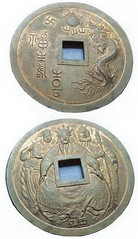 There is a tiny inscription at the bottom rim of the dragon side that appears to be in Roman letters - what does it say? The "Chinese" is very stylized - I can make out only the character for luck or good fortune on the dragon side, and possibly a name, Kung Kuan, on the bottom of the portrait side.
There is a tiny inscription at the bottom rim of the dragon side that appears to be in Roman letters - what does it say? The "Chinese" is very stylized - I can make out only the character for luck or good fortune on the dragon side, and possibly a name, Kung Kuan, on the bottom of the portrait side.
To read the earlier E-Sylum article, see: QUERY: IS MYSTERY TOKEN A THOMAS ELDER PRODUCT? (www.coinbooks.org/esylum_v13n40a12.html)
Finally, Joe adds:
"The Bureau of Engraving and Printing ... has identified a problem with sporadic creasing of the paper during printing of the new $100 note."
I'm not surprised. The new "Motion" thread embedded in the paper adds localized thickness to the paper - if you look at a stack of the sheets, there is a noticeable hump in it. But considering how long they have been printing these, I'd have thought they would have worked out any problems before now.
To read the earlier E-Sylum article, see: ANOTHER BANKNOTE PAPER PROBLEM: BEP DELAYS NEW $100 BILL (www.coinbooks.org/esylum_v13n40a19.html)
QUERY: HOW TO REMOVE PAPER MONEY FROM A LAMINATED ENCASEMENT
Alan writes:
Perhaps four years and hundreds more E-Sylum readers will make a difference. In early 2006 I asked if anyone knew how to remove a rare banknote from its heat-laminated plastic tomb. I got no answers. I have not been able to discover how to dissolve or vaporize the plastic without harming the paper or inks embedded within. Perhaps it is a technical impossibility, like restoring a scrambled egg to its original state in the shell. Nevertheless I haven't given up hope... Please help!!"
Gary Niditch writes:
On a related topic, about 15 years ago I visited the Bureau of Engraving and Printing in Washington, D.C. and purchased in their gift shop two blocks of Lucite each containing a new $1 bill. Both are 1988 district 7 (Chicago). I have no idea if these are still sold at the BEP.
I still find these intriguing. I have no idea how they could create a block of Lucite with the bill almost perfectly centered so that it looks like it's floating without damaging the note.
Back on the topic of Lucite-encased coins, Alan V. Weinberg forwarded a link to this recent eBay sale - an 1819 Bust Half Dollar encased in a Lucite company 150th anniversary souvenir.
To read the eBay lot description, see: 1819 CAPPED BUST HALF DOLLAR PAPERWEIGHT 1819 50c (cgi.ebay.com/ws/eBayISAPI.dll?ViewItem&item=350396168384)
To read the earlier E-Sylum article, see: MORE ON COINS AND MEDALS EMBEDDED IN LUCITE (www.coinbooks.org/esylum_v13n40a14.html)
QUERY: INFORMATION ON RICHARD D. KENNEY SOUGHT
Web site visitor Alan P. Kenney writes:
My father was Richard D. Kenney who passed away in 1956. I happened upon your web site by accident, and saw reference to my father. I would greatly appreciate any information your readers could provide me on my father's career or writings. Thank you in advance. My father originally worked at Macy's, New York and moved to Louisville KY to work for James and Co. He appeared at least once on television discussing numismatic topics.
The Numismatic Indexes Project (NIP) lists 45 entries for Richard Kenney. Many of the entries are for articles in the Coin Collector's Journal volumes 15-21 (1948-1954) on "Early American Medalists and Die-Sinkers (Prior to the Civil War)" and "Struck Copies of Early American Coins", and a series of articles on "Unofficial Coins Of The World" in The Numismatist 1962-1964. His obituary appeared in the March, 1957 issue of Numismatic Scrapbook. Here is an image of the cover of a CCJ offprint of "Struck Copies of Early American Coins", a classic monograph on an important aspect of U.S. numismatics. -Editor
To access the Numismatic Indexes Project (NIP), see: www.harrybassfoundation.org/lit/NumismaticIndexes_list.asp
THE BOOK BAZARRE
QUERY: CALIFORNIA REFINERS OF NEVADA BULLION SOUGHT
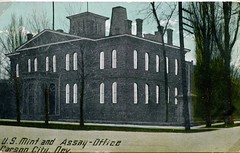 I've been doing some research (in the Mint Annual Reports) regarding bullion deposits at the Carson City Mint. Keeping in mind the "accepted wisdom" that the tariffs of the local railroad(s) were set to make it advantageous for local bullion to be shipped to the San Francisco Mint instead of to the Carson City Mint, I expected to find that much more Nevada bullion went to San Francisco than to Carson City.
I've been doing some research (in the Mint Annual Reports) regarding bullion deposits at the Carson City Mint. Keeping in mind the "accepted wisdom" that the tariffs of the local railroad(s) were set to make it advantageous for local bullion to be shipped to the San Francisco Mint instead of to the Carson City Mint, I expected to find that much more Nevada bullion went to San Francisco than to Carson City.
However, what I found was this: For the 1870 to 1899 period, of the Nevada gold that was deposited at the various mints, Carson City received 62%, the New York Assay Office received 23% and the San Francisco Mint received 13%. Of the Nevada silver, Carson City received 37%, San Francisco received 41%, the New York Assay Office received 12% and the Philadelphia Mint received 10%.
These percentages are subject to some adjustment depending on whether you include "gold parted from silver" or bullion deposited in bar form at the Carson City Mint as "Nevada" bullion. (Obviously, one wouldn't be able to draw any such conclusions regarding the same categories from the San Francisco Mint.)
Frankly, I expected to find that San Francisco had received a larger percentage of Nevada bullion (especially of silver). Considering the size of the Carson City Mint and the amount of time it was closed for one reason or another, I wouldn't necessarily conclude from the deposit records that the Carson City Mint had been unfairly deprived of bullion
Can anyone offer some additional insights? Does anyone know if there were other refiners in California that might have received and then exported Nevada bullion (and which therefore would have escaped the Mint records entirely)?
THE COLONIAL COIN & STAMP COMPANY
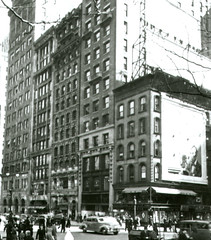

I've enjoyed Harvey Stack's stories about the coin business in New York. In his list of dealers active there during the 1930s he mentioned all those well known today, but he omitted one name that was prominent at the time and since forgotten.
When I was researching my book on coin boards, one of the publishers was Colonial Coin & Stamp Company of NYC. These were the Cadillacs of coin boards, with clear cellophane backings that showed both sides of the coins. The owner of CC&S Co. was Leiser W. Schnelling. While NYC directories of the years 1935-40 included all of the dealers mentioned by Harvey, the largest ads and the only ones featuring graphics in addition to text were those of Colonial.
Schnelling was evidently a big buyer and seller at the time, but he entered the Army in 1942 and seems to have been never again connected with the coin business. He died in 1981, completely forgotten by the hobby until my book resurrected his name. I wonder whether Harvey has any recollection of Schnelling or Colonial.
I'm attaching a couple photos that show the company's location at 505-507 Fifth Avenue in 1940, one block east of Stack's. Number 507 has a white arrow pointing to it, while 505 (to the right of it) has the company's name and logo painted in the second story windows. The blowup reveals the Colonial Coin & Stamp Company logo of the Statue of Liberty, which also appears on its coin boards.
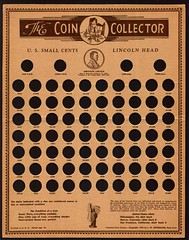
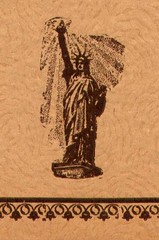
Harvey writes:
Though I was not active in the coin business as a full time dealer until 1947, I did have the opportunity to know many of the old-timers prior to that date. While I was still going to school, especially in the late 1930's and l940's, I worked part time (virtually every Saturday and Holiday that I didn't have school work to do), and I am sorry to say I do not recall a Colonial Stamp and Coin Co in NYC, located at 507 Fifth Avenue. As the address indicates that the location of the firm was near 42nd Street in NYC,, and Stack's in the early 1940's was located on 46th Street, near Fifth Avenue. I do not remember the Colonial name, nor the proprietor Leiser W. Scnelling.
There were a number of stamp and coin dealers in NYC and I wonder though it was called Colonial Stamp and Coin, if their specialty was Stamps and Stamp albums (a big business at that time.
The only Colonial Stamp and Coin Co. that I remember during the post World War II period was located in Cleveland, Ohio.
To read the earlier E-Sylum article, see: HARVEY STACK: HOW NEW YORK BECAME THE COIN CAPITAL (www.coinbooks.org/esylum_v13n40a08.html)
HOLABIRD-KAGIN WESTERN AMERICANA AUCTION OCTOBER 29-30, 2010
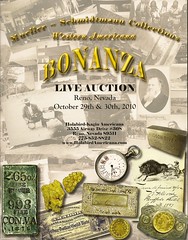
Lot #243~Tucson~Pima County~Pinal Gold and Silver Note
~C1880~Note No. 167. This Pinal Gold and Silver Mining Company one-dollar note is probably the only such note extant. Extremely Rare, One Dollar U.S. Currency #167 printed on bond paper. “One Dollar” printed in center, signed by J. M. Morrison, Superintendent.
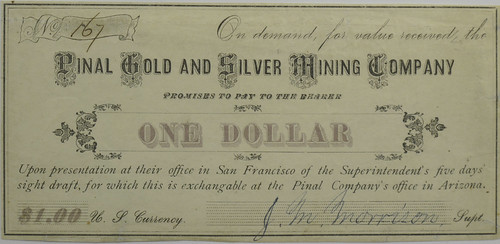
The Pinal Gold and Silver Mining Company was formed in late 1876 and operated until about 1879. It was reformed in the mid 1880's as the Pinal Consolidated MC with significant production.
The Pinal Gold & Silver MC office was located in San Francisco, at 402 Montgomery, from 1876 until 1878. The superintendent listed on the bank note, J. M. Morrison, is not listed as a resident of San Francisco during that period and may have been the mine Superintendent in Arizona,
Lot #896~Rosita~J.W. Pringle Silver Ingot 3.50 oz. ~c1873

James William Pringle was born in Scotland in 1838. Many members of the Pringle family immigrated to America for various mining rushes. James, along with other family members, first settled in New York. In 1857 he was off to California to seek a fortune in gold. According to his biography, he was "fairly successful" in California, remaining there until 1864.
Learning "placer mining" in California, Pringle took his trade to the gulches of eastern Oregon, Idaho and Montana. By 1870, Colorado got his attention, and he was one of the early prospectors to venture into the San Juan Mountains, which later became an area of intense prospecting and metal production.
Pringle found silver in Rosita, and there he made his home, and a name for himself. Silver was discovered here in 1870.
 Lot #1005~Fort Robinson~Dawes County~Token Breast Plate
~Ornamental breast plate made of 26 tokens from Fort Robinson. Two five cent tokens, eighteen dimes, two quarters, and four dollars. Of the rare L.D. Carson post exchange. Connected to form a fabulous Lakota Sioux breast plate. Circa 1900-1910. Camp Robinson in Northwest Nebraska was home to 13,000 Lakotas in the 1870s.
Lot #1005~Fort Robinson~Dawes County~Token Breast Plate
~Ornamental breast plate made of 26 tokens from Fort Robinson. Two five cent tokens, eighteen dimes, two quarters, and four dollars. Of the rare L.D. Carson post exchange. Connected to form a fabulous Lakota Sioux breast plate. Circa 1900-1910. Camp Robinson in Northwest Nebraska was home to 13,000 Lakotas in the 1870s.
For more information on the sale, see:
www.holabirdamericana.com
MORE ON THE DALTON GANG QUARTER
Alan V. Weinberg writes:
 I examined the Bob Dalton Coffeeville (sic) 1895 quarter in Stack's Terranova counterstamped coin collection auction in Philadelphia. The piece struck me just as peculiar as when I first saw the plate in the catalogue weeks before. The 1895 quarter is well worn, in perhaps barely Good condition. Yet the engraved (not counterstamped) inscription was crisp, sharp and devoid of any dirt or verdigris in the letter recesses.
I examined the Bob Dalton Coffeeville (sic) 1895 quarter in Stack's Terranova counterstamped coin collection auction in Philadelphia. The piece struck me just as peculiar as when I first saw the plate in the catalogue weeks before. The 1895 quarter is well worn, in perhaps barely Good condition. Yet the engraved (not counterstamped) inscription was crisp, sharp and devoid of any dirt or verdigris in the letter recesses.
If indeed the inscription was done in or around 1895 when the coin was choice, the inscription would, like the coin, show a lot of wear and a lot of residue in the letters. The same can be said if it were merely carried as a pocket piece. The incused inscription would be almost as well worn as the coin.
MORE ON THE CALIFORNIA HUMIDOR
Phil Iversen writes:
The second medal on the bottom row is HK-359 copper Utah exhibit medal from the Alaska-Yukon-Pacific Exposition, the third looks to be also an HK medal of Rear Admiral Evans from the 1908 United States Navy World Voyage. The fourth one looks like an medal from the 1915 Pan-Pacific International Exposition held in San Francisco. I'm sure your other readers will be able to determine the rest.

To read the earlier E-Sylum article, see: NUMISMATIC WINE AND CIGARS (www.coinbooks.org/esylum_v13n40a18.html)
ELONGATED COIN-MAKING MACHINES IN JAPAN
Dick Johnson writes:
Collectors of elongated cents might want to visit Japan. Machines at tourist areas roll out elongated coins - your choice of three varieties for 100 yen each. A young photographer made this shot of the machine, and a video of his purchasing one.
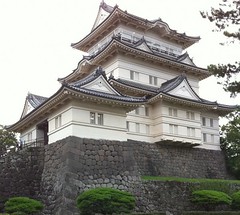
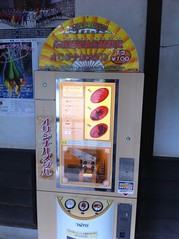
This is an interesting blog post with some great photos of the buildings and grounds of Odawara Castle. I've never visited Japan, but this looks like a wonderful destination. -Editor
To read the complete article, see:
Odawara Castle
(kesenaitsumi89.wordpress.com/2010/08/21/
odawara-castle%E5%B0%8F%E7%94%B0%E5%8E%9F%E5%9F%8E/)
DIGITIZING THE PERSONAL LIBRARY
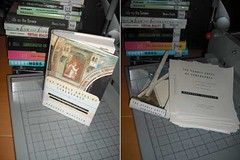 Books take up space. That's a problem for any librarian tasked with finding room on overcrowded shelves. It's also a problem for a book-loving scholar who lives in a small New York City apartment with a toddler and more than 3,000 books. Under those conditions, something's got to give. Chances are good it won't be the toddler.
Books take up space. That's a problem for any librarian tasked with finding room on overcrowded shelves. It's also a problem for a book-loving scholar who lives in a small New York City apartment with a toddler and more than 3,000 books. Under those conditions, something's got to give. Chances are good it won't be the toddler.
Alexander Halavais, an associate professor of communications at Quinnipiac University, found a partial solution to his city dweller's no-space-for-books dilemma: Slice and scan. A digital file takes up a lot less room than a codex book does.
In a post on his blog, A Thaumaturgical Compendium, Mr. Halavais described what he had done to some 800 of his books so far: "First I cut the boards off, and then slice the bindings. I have tried a table saw, but a cheap stack cutter works better. Then I feed [the pages] into my little page-fed scanner, OCR them (imperfectly) using Acrobat, and back them up to a small networked attached storage device." (See before-and-after pictures, above.) Many of the scanned books he also stores as image files.
The process is slow and, yes, painful. "I'm over a thousand books in, and even now I get that—especially with hardcovers, for some reason—that gut feeling of 'Will I be judged by the book gods for doing this?'" Mr. Halavais said in an interview. "Destroying books is very difficult. If I could do this in a non-destructive way, I would."
Google can draw on multitudes of technicians and high-end equipment for its huge book-scanning project. Mr. Halavais does it all himself and works with technology that suits a scholar's budget. He has a Fujitsu ScanSnap that "cost maybe $400," he said, pointing out that if you're handy you can build your own scanner out of scrap for a hundred bucks.
The top candidates for translation into the digital sphere are books Mr. Halavais might want or need to consult for his research, which focuses on social computing. (As he explains on his blog, he examines "the ways new communication technologies are affecting politics, government, education, journalism, and business.") So his library contains books about technology and society and politics. "A lot of it is political science from the 1960s," Mr. Halavais said, as well as works such as Nicholas Negroponte's Being Digital (Vintage, 1995) and some of Bill Gates' oeuvre. Most are things that Mr. Halavais might want to cite now and then but is unlikely to reread all the way through.
Mr. Halavais plans to keep about 500 of his 3,000 books in codex form. Fiction and unique or lovely books won't get the slice-and-scan treatment. Books heavy on photography or art don't scan well and are spared. So are books with sentimental value. "I still have my mom's copy of Das Kapital with her marginalia in it," Mr. Halavais said. "That's stuff that I probably won't scan, because I like to have it in the physical form."
The Chronicle asked Mr. Halavais whether the scanned books still felt like a library. Without a physical presence, "no, they really don't," he said. The scanned material "feels like a resource, but it does not feel like a library in the same way."
Mr. Halavais described his scanning project to an audience of publishers at the Association of American University Presses' conference in June as part of a talk on "The New University Press." He expected the audience to be dismayed. "They weren't really," he said. "In the publishing industry, remainders get destroyed."
His students, however, are appalled when he describes what he does to his books. "I have students who are very digitally minded and are in a program in interactive communication, but they're aghast at the idea that I scan [books] and that I destroy them afterwards," he said. "Both of those are really disturbing to them."
As for himself, "I will always have a bookcase," Mr. Halavais said. "But when I was a kid I thought when I grew up and became rich and famous, I would have a library room. That seems very unlikely now."
To read the complete article, see: Digitizing the Personal Library (chronicle.com/blogPost/Digitizing-the-Personal/27222/)
CONFESSIONS OF A USED-BOOK SALESMAN
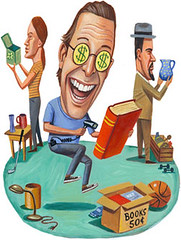 I make a living buying and selling used books. I browse the racks of thrift stores and library book sales using an electronic bar-code scanner. I push the button, a red laser hops about, and an LCD screen lights up with the resale values. It feels like being God in his own tiny recreational casino; my judgments are sure and simple, and I always win because I have foreknowledge of all bad bets. The software I use tells me the going price, on Amazon Marketplace, of the title I just scanned, along with the all-important sales rank, so I know the book's prospects immediately. I turn a profit every time.
I make a living buying and selling used books. I browse the racks of thrift stores and library book sales using an electronic bar-code scanner. I push the button, a red laser hops about, and an LCD screen lights up with the resale values. It feels like being God in his own tiny recreational casino; my judgments are sure and simple, and I always win because I have foreknowledge of all bad bets. The software I use tells me the going price, on Amazon Marketplace, of the title I just scanned, along with the all-important sales rank, so I know the book's prospects immediately. I turn a profit every time.
I'm pretty sure I first heard about the practice of shopping for books with laser scanners in a story on NPR, which, as I recall it, disparaged their use as classless. And, really, it is precisely this. The book merchant of the high-cultural imagination is a literate compleat and serves the literate. He doesn't need a scanner, because he knows more than the scanner knows. I fill a different niche—I deal in collectible or meaningful books only by accident. I'm not deep, but I am broad. My customer is anyone who needs a book that I happen to find and can make money from.
When I first started this work, I would wake up every morning with fingers stiff from prying apart books in order to get a better look, and a clear shot at the barcode. On average, only one book in 30 will have a resale value that makes it a "BUY." One man's trash is, of course, nearly always another man's trash.
Lately, I've been averaging about 30 books sold per day. I pull them down, fit them into padded envelopes, print postage at home, and drive my packages to the post office before closing time—six days a week. After this, I usually go out looking for more stock, and after that I often stay up late making new listings online—describing the physical faults of my books, deciding on prices. I work up to 80 hours a week.
To read the complete article, see: Confessions of a Used-Book Salesman (www.slate.com/id/2268000/)
THE BOOK BAZARRE
BRITISH POLICE RAID OFFICE OF BANKNOTE MAKER SECURENCY
More than 100 police and investigators from Britain's Serious Fraud Office carried out searches last night (AEDT) at nine properties connected to Securency International, a joint venture between the Reserve Bank of Australia and Innovia Films, a British chemicals manufacturer.
Securency, an Australian-based company that makes polymer films used to protect banknotes, is being jointly investigated by the SFO and the Australian Federal Police.
"It involves the activities of employees and agents of Securency International and their alleged corrupt role in securing international polymer banknote contracts," the SFO said.
Last night (AEDT) investigators and police searched eight homes in Surrey, Hampshire and the Thames Valley, as well as Securency's offices in Cumbria.
It is one of the biggest raids that the SFO has carried out. Two men were arrested. They are believed to be employees of Securency or agents who had acted on behalf of the company.
To read the complete article, see:
Police raid RBA's banknote venture in global bribery probe
(www.theaustralian.com.au/business/industry-sectors/
police-raid-rbas-banknote-venture-in-global-bribery
-probe/story-e6frg96f-1225935243915)
COUNTERFEITER CAUGHT MAKING $5 BILLS INTO $100S
Toothbrushes and oven cleaners were just some of the things federal agents said a Michigan man was using to make counterfeit money.
According to a criminal complaint filed in the United States' attorney's office for the Eastern District of Michigan, the man is accused of altering legitimate $5 bills into $100.
Agents said they began conducting undercover surveillance in early September at the Best Western Hotel in Allen Park, watching a man -- and at times two other people -- make runs back and forth between a Dollar General in Melvindale and room 329 at the hotel.
The men were seen purchasing baking sheets, oven cleaner and toothbrushes, the complaint said -- all of which are commonly used to bleach currency.
Agents said when they executed a search of the hotel room, they found "counterfeit $100 bills sticking out from underneath the mattress of the bed," counterfeiting supplies and a printer/copier.
The complaint said 49 counterfeit $100 bills and eight bleached $5 bills were found.
To read the complete article, see: Feds: Man Was Making $5 Bills Into $100s (www.clickondetroit.com/news/25290261/detail.html)
FUTURE MONEY: NEW CURRENCY FOR SPACE TRAVELERS
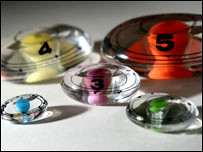
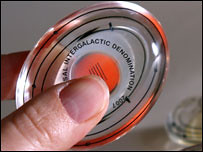
Scientists have come up with a new currency designed to be used by inter-planetary travellers.
It is called the Quasi Universal Intergalactic Denomination, or Quid.
It is designed to withstand the stresses of space travel and has no sharp edges or chemicals that could hurt space tourists.
It was designed for the foreign exchange company Travelex by scientists from the National Space Centre and the University of Leicester.
"None of the existing payment systems we use on earth - like cash, credit or debit cards - could be used in space," said Professor George Fraser from the University of Leicester.
"Anything with sharp edges, like coins, would be a risk to astronauts while the chips and magnetic strips used in our cards on Earth would be damaged beyond repair by cosmic radiation," he added.
Using any sort of technology that involved sending and receiving information from Earth would also be impractical because of the distances involved.
Quids are made of the polymer best-known for its use in non-stick pans.
The [Quids] have moulded edges so that they will not damage anything if they accidentally float free in zero gravity.
National Space Centre scientists predict that regular trips into space will be commonplace in the next five years and that tourist facilities on the Moon are a distinct possibility by 2050.
Speaking of making stuff up, I'm reminded of those corporate team-building exercises where people are asked "Tell us something about you that most people wouldn't know." Since my life is so ordinary, I make stuff up, like "I played bongos for the Stones on Sympathy for the Devil" or, "I was born a woman..." -Editor
To read the complete article, see: New currency for space travellers (news.bbc.co.uk/2/hi/business/7029564.stm)
LARRY MITCHELL ON LUST IN THE STACKS
Ah, libraries!
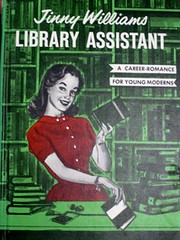 All those books! All those really, really smart librarians! All those nooks and crannies! Just the thing for a higher-class romance ... a little discrete necking ... a nice little venue in which to hide a body....
All those books! All those really, really smart librarians! All those nooks and crannies! Just the thing for a higher-class romance ... a little discrete necking ... a nice little venue in which to hide a body....
Libraries and librarians have long been protagonists and foils in everything from romances to mysteries to science fiction. Like bookstores, libraries frequently are stocked with attractively intelligent and/or eccentric characters. Many of the books found in libraries are extremely valuable. And many libraries contain plenty of well-hidden places within which to develop a good plot. Perhaps that is why so many writers pen bibliomysteries, and why so many book collectors--even if they do not generally collect such books--often are drawn to bibliomysteries that feature libraries and librarians.
And lest we forget, all those nooks and crannies, all those intelligent and attractive librarians, are great fodder for affaires du coeur. Which brings me to the point of today's post....
Bookstores and libraries across the country are being shuttered. While SciFi writers probably will still find uses for librarians and libraries in a world without printed books (as devotees of Star Trek and Star Wars will attest), what is going to happen to the bibliomystery if this trend continues? Will Kindles and Nooks and iPads replace printed books as objects of bibliophilic lust?
More importantly, perhaps, how will attractive and intelligent librarians find love in the stacks when there no longer are any stacks...?
To read the complete article, see: Lust in the Stacks No Longer...? (www.finebooksmagazine.com/fine_books_blog/2010/10/lust-in-the-stacks-no-longer.phtml)
FEATURED WEB SITE: THE MARIA THERESA THALER
This week's Featured Web Site about Austria's Maria Theresa Thaler. It was suggested by Tom Kays. Thanks! He writes:
I never knew so many countries made Maria Theresa Talers!
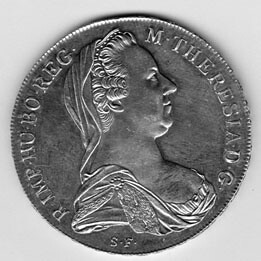
The Maria Theresa Thaler is probably one of the most famous and well known coins of the world.
Originally struck in Austria from 1740 to 1780, the Thaler was the currency of the Austrian Empire. It was very important for trade with the Levant (parts of Turkey, Lebanon, Syria). Over time, the Maria Theresa Thaler became the best known and most popular silver coin in the Arabian world. After the death of Empress Maria Theresa in 1780, Joseph II permitted the Austrian mint to continue striking the coin with the 1780 dies in order to meet demand from the Middle East. The 1780 taler was the only silver coin that the Arabs trusted and would accept.
Since then, the Maria Theresa Thaler has been restruck for trade purposes at Vienna, Austria with the 1780 date frozen in time. The taler became the unofficial currency in some areas of Africa and Asia, and may still be in use today as a "trade silver dollar" in some Arabian bazaars.
www.mtt.roeck-us.net/en/
